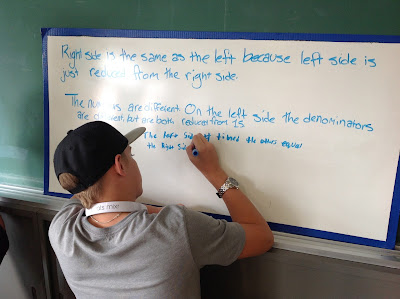Once everyone had a figure I had them share with the rest of their group and discuss their thinking. Then I gave them another one to consider on their own.
As we were finishing up, one of the students said "Next you're going to get us to draw a figure that has the same area and perimeter. Aren't you?". I actually hadn't considered that as an option, but since he brought it up, I thought it would be a great idea. Most students thought it was easy and they drew a square. I asked a few to show some dimensions so we could compare the perimeter and the area. Many of them just wrote down a length and a width at random. We discussed, as a class, the shapes and dimensions they chose. Their answers were mostly squares that were 1x1, 2x2, 3x3 and 4x4. I drew a 1x1 and asked about the area and perimeter. Students quickly began changing their minds. We realized that a 4x4 would work. I asked if there were any others. Some suggested multiples of 4, then did a calculation to see if it would work. One student suggested 40x40 only to realize that the area and perimeter differed by a factor of 10. One girl pointed out that the areas were getting bigger faster than the perimeters so there couldn't be any more squares that had equal areas and perimeters. Wow! This would have been a good time to pull out Desmos and graph the perimeter vs. side length and area vs. side length to compare the graphs. Unfortunately, I didn't.
Next, we moved onto using a certain number of toothpicks to create all possible rectangles, using all of the toothpicks (we used pieces of straws rather than toothpicks). I gave each group eight straws and I asked them to keep track of the length, width, perimeter and area of each rectangle.
They repeated the process with twelve and sixteen straws. Then they were asked to look back at their tables to see what they noticed. They needed a push in the right direction but it didn't take too long before they were able to find what I was hoping for. Hopefully this portion gets easier for them as they do it more.
We moved onto minimizing perimeter given a certain area. I gave out linking cubes and asked them to do the same sort of thing using 9, 16 and 25 cubes. The instructions I gave can be found here.
Some groups finished and were ready for the homework a couple of minutes before the bell. Others got far enough that they could finish up at home. Here's a link to the homework I gave. I feel like I stole this from someone. If it was you let me know so I can give you credit.






































